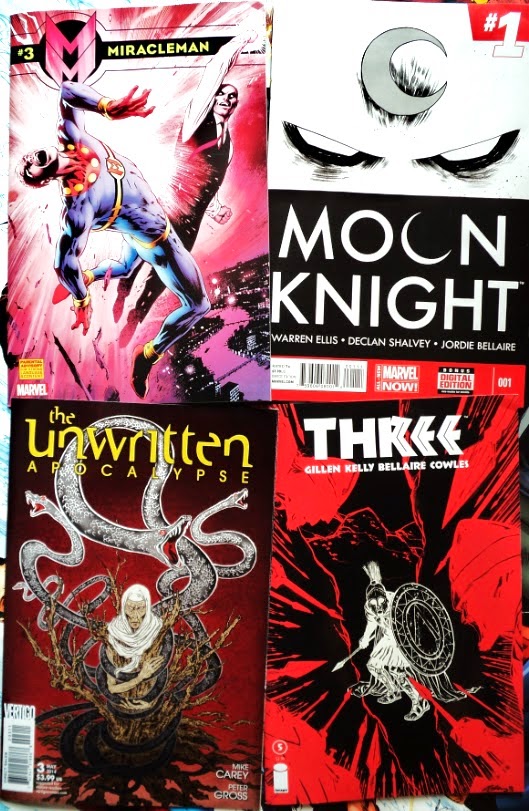Warren Ellis takes this premise as the starting point of “Island” (published in Planetary # 2, May 1999), and expands on it very creatively. What would have happened if real monsters had existed on our planet? Where would they’ve gone to die? The answer is a refreshing cocktail of references that include WWII and B-movies from the 50s.
When Elijah Snow, Jakita Wagner and the Drummer travel to Japan to visit the subsidiary offices of Planetary –funded by the mysterious Fourth Man, the same individual responsible for sponsoring the Archeologists of the Impossible– they make a startling discovery: the security perimeter in Island Zero has been breached. But what secrets remain buried in there?
Hiroshima was the target of the first atomic bombs in history. But something happened that day. Perhaps it was the radiation or something far more sinister… anyway, the result was mindboggling, to say the least. Gigantic monsters started to appear on Island Zero. Monsters strangely similar to Godzilla and other B-movie creatures. In the 50s, these monsters reigned supreme on an island that no one dared to visit, and at the same time Godzilla movies were all the rage; however, in the 70s, productions about scaly, giant lizards were not popular anymore, and around that time, the decline of the monsters from the Japanese island begun.
 |
| Mothra |
 |
| King Ghidorah |
“Island” is an amazing self-contained episode written with the necessary nostalgia to make us feel sympathetic towards the traditional figure of the monster, while at the same time serves as an examination of the consequences of war, nuclear attacks and governmental secrecy.
John Cassaday’s art is exceptionally brilliant. The double page spread where we can see the Japanese expedition admiring the insectoid Mothra combines fantasy and horror elements, B-movie sensibilities, Ray Harryhausen’s approach to special effects and real life scenarios into one powerful image. The skeleton of King Ghidorah –a dragon with 3 heads– looks quite menacing, even if it represents no immediate danger. The dead Godzilla is equally creepy and reinforces the mystery of Island Zero. How did they all die? What inscrutable instinct led them to this graveyard? Finally, the cover is a heartfelt homage to the classic Godzilla posters from Toho Studios.
________________________________________________________________________________________________
________________________________________________________________________________________________
La muerte tiende a la homogenización. No presta atención a la religión, la nacionalidad ni el estatus socioeconómico, y envía rápidamente a todos los fallecidos al mismo lugar: el cementerio. Pero, ¿esto se aplica únicamente a nosotros? Tal vez los animales también reflexionan sobre su propia muerte. Hay relatos míticos de buscadores de marfil que descubren cementerios de elefantes, vastas regiones en las que estas criaturas colosales se reunían para exhalar el último aliento antes de caer y unirse a los suyos.
 |
| Godzilla |
Warren Ellis toma esta premisa como el punto inicial de “Isla” (publicado en Planetary # 2, mayo de 1999), y la expande de manera muy creativa. ¿Qué habría pasado si hubiesen existido monstruos en nuestro planeta? ¿Adónde habrían ido a morir? La respuesta es un refrescante cocktail de referencias que incluyen a la Segunda Guerra Mundial y a las películas de serie B de los 50s.
Cuando Elijah Snow, Jakita Wagner y Drummer viajan a Japón para visitar la oficina subsidiaria de Planetary –financiada por el misterioso cuarto hombre, el mismo individuo responsable de auspiciar a los arqueólogos de lo imposible– descubren algo espeluznante: el perímetro de seguridad en la Isla Cero ha sido penetrado. Pero, ¿qué secretos están enterrados allí?
Hiroshima fue el blanco de las primeras bombas atómicas de la historia. Pero algo pasó ese día. Tal vez fue la radiación o algo mucho más siniestro... de todos modos, el resultado fue increíble. Monstruos gigantescos empezaron a aparecer en la Isla Cero. Monstruos extrañamente similares a Godzilla y a otras criaturas de películas de serie B. En los 50s, estos monstruos reinaron en una isla que nadie se atrevía a visitar, y al mismo tiempo las películas de Godzilla estaban de moda; sin embargo, en los 70s, las producciones sobre lagartos gigantes y escamosos ya no eran tan populares, y por esos años, comenzó el declive de los monstruos de la isla japonesa.
 |
| Island Zero |
En 1999, un grupo de insurrectos asiáticos desembarcan en la Isla Cero, ignorando lo que podrían encontrar allí. Como arqueólogos improvisados, encuentran los esqueletos imposiblemente grandes de monstruos que desafían la lógica y la naturaleza. Mothra yace disecado en un valle desértico; a poco distancia se pudre el kilométrico cadáver de Godzilla... Elijah y Jakita han llegado demasiado tarde, no hay secretos que proteger, sólo restos, carcasas sin vida de criaturas que nunca pertenecieron a este mundo.
“Isla” es un asombroso episodio autoconclusivo, escrito con la nostalgia necesaria para hacernos sentir compasión por la figura tradicional del monstruo, mientras que al mismo tiempo sirve para examinar las consecuencias de la guerra, los ataques nucleares y los secretos gubernamentales.
El arte de John Cassaday es excepcionalmente brillante. La página doble en la que vemos a la expedición japonesa admirando al insectoide Mothra combina fantasía y elementos de terror, la sensibilidad de las películas de serie B, el enfoque de efectos especiales de Ray Harryhausen y escenarios de la vida real en una poderosa imagen. El esqueleto de King Ghidorah –un dragón con 3 cabezas– se ve bastante amenazador, incluso cuando no representa peligro inmediato. El Godzilla muerto es igualmente tenebroso y refuerza el misterio de la Isla Cero. ¿Cómo murieron todos? ¿Qué inescrutable instinto los guió a este cementerio? Finalmente, la portada es un sentido homenaje a los clásicos afiches de Godzilla de Toho Studios.



























